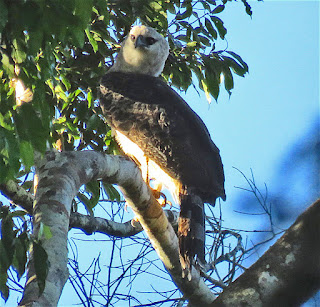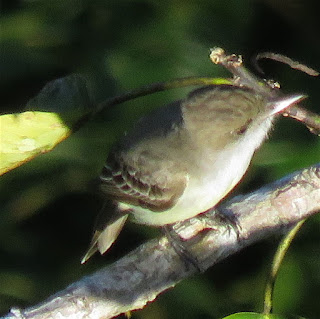I just
returned to civilization from my week of cooking for the WINGS tour at Gambell,
Alaska. Seven days, three gourmet meals a day for 15 people…up at 4:20 a.m.
each day, in bed no earlier than 10:30 p.m., but sometimes I went birding and
didn’t get in until after midnight. So 18-20 hours every day. It was exhausting,
yet exhilarating and very rewarding.
After spending two days in Anchorage buying nearly
$2000 worth of perishables and organizing it all in 23 boxes and our stored
coolers, I joined the WINGS tour group, and we all took the flight from Anchorage to Nome on Alaska Airlines. Our
route took us over the terrain covered by the Iditarod race.
Approaching
Nome, we flew over Safety Sound, well known among birders.
Then we
transferred to the Bering Air terminal for our 50 minute flight SW over the
Bering Sea to Gambell.
Approaching Gambell,
on the northwestern-most tip of St. Lawrence Island.
Here’s the kitchen
workspace I shared with the cooks of other birding groups in the Sivuqaq Lodge.
I baked a
lot of bread – seven different kinds including six loaves of challah for
breakfast strata and French toast.
This is the
famous no-knead bread that takes very little effort and work time.
Jennifer
Jolis was the cook for the VENT tour, and behind her is her assistant Ahi.
I made
buttermilk and buckwheat pancakes for breakfast one morning, and my leaders
(Gavin Bieber here) and sometimes even the participants helped take the food
out to the dining area each meal.
Here’s the
group at dinner one night.
One of the
more ambitious meals I prepared was what I called Nepali Night à la Saraswoti.
Saraswoti is the head cook and nanny for my friends Kate and Mich, who are
living in Kathmandu, and when I visited them this past April I helped Saraswoti
in the kitchen from time to time and took notes.
Here are
most of the main ingredients I bought in Tucson and shipped up here.
The day
before I had to make the paneer from whole milk, buttermilk, and lemon juice.
From left to
right are fried tofu salad, chatpate, fried paneer curry, cauliflower curry,
chana dal, and basmati rice.
Chatpate is
traditionally a spicy street snack in India and Nepal, served in a cone of
newspaper, but it’s mostly fresh vegetables and serves perfectly as a salad,
perked up by crunchy potato noodles and puffed rice.
On the last
night I made Lemon Mousse Pie, a huge hit. I’ll be making this one again.
I did get
out birding on five occasions, three of which were spurred by the presence of a
Pallas’s Bunting, found by Stephan Lorenz. I missed it the first two times,
seeing a super rare Siberian Chiffchaff as a consolation (but I saw one here
two years ago) but when I went out on my own the third time on June 1, I got
fabulous views – and of course, that’s when I forgot to bring my camera. It was
my ABA bird #753. There are about seven previous records for the United States,
and this is the first verified spring record from Gambell. It mostly hung out
in what is called the Circular Boneyard; here a Walrus skull in the foreground
where I had it.
I looked for
but did not see the Hawfinch and Eyebrowed Thrush that were south of the boneyards.
Find the Snow Bunting in this boulder field near the same location.
This is Troutman
Lake, always still frozen this time of year.
Red-necked Phalarope
is a common breeder in any little puddle of water. The female is the stunning,
more colorful of the pair.
Common
Redpolls forage on seeds in the boneyards.
Lapland
Longspur is the most common breeding passerine here.
Much of the
birding time at Gambell is spent at the northern point watching seabirds fly by as one looks towards the Chukotsky Mountains of Russia.
On June 5,
we flew back from Gambell to Nome.
From up high
we had a much better view of the very mountainous Chukotsky Peninsula.
Here’s a
shot of the GPS screen on our flight from Gambell to Nome – east is straight up.













































